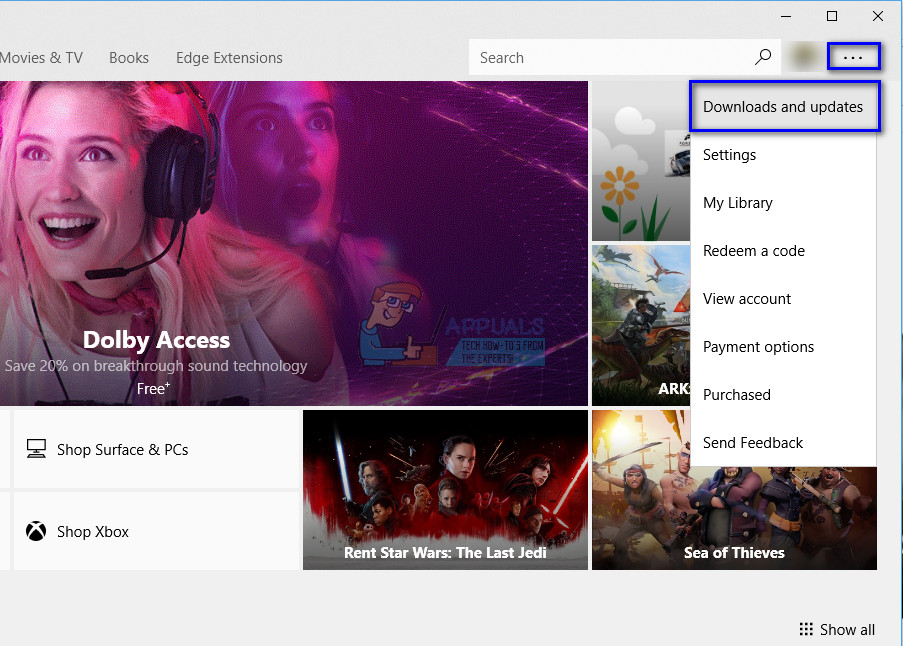With that being said, there are several cases where Windows 10 applications fail to launch. They either do not launch at all or work partially. This is a known issue with the operating system and in most cases, means that your Windows installation was done correctly. If the iso file was corrupt or the installation failed in some module, the applications will not launch.
Solution 1: Updating Applications using Store
We can try updating the applications using Windows Store before moving on to more technical methods involved. Make sure that your Windows is updated to the latest version before moving on with the solutions. Microsoft periodically releases various bug fixes for different situations. It is possible the problem you are facing is already addressed in the latest update.
Solution 2: Re-registering the applications
If you cannot update the applications or they still do not work after the update, you can try registering them using PowerShell. You might get a lot of error lines when you execute the command but that is normal and there is nothing to worry about. Do note that you will require administrative privileges to perform this solution.
If this single command doesn’t work, you can try executing the following commands in the exact order as specified. Make sure to wait until one command is completed. These commands will reinstall all the applications for the user.
Solution 3: Resetting the Store Cache
The primary reason the applications don’t launch is that either their installation is corrupt or the store is not allowing them to update to the latest version. In the latter version, we can try resetting the store cache and see if you can update them without any problems. The Store cache is there to cache data and it attempts to use it over and over it. Resetting it clears everything and forces it to fetch data again. $bundlefamilies = (get-appxpackage -packagetype Bundle).packagefamilyname get-appxpackage -packagetype main |? {-not ($bundlefamilies -contains $.packagefamilyname)} |% {add-appxpackage -register -disabledevelopmentmode ($.installlocation + “\appxmanifest.xml”)}
This process might take a few minutes. Let the operation complete. After the cache is cleared, Windows Store will open automatically. Search for potential updates and see if this does the trick.
Solution 4: Resetting the Specific Application
If a specific application is not launching, you can reset it using Settings. This will, in turn, reset the application as if it was never used and also clear all the user data associated. Do note if you have any data saved inside the application, it will be lost and may not be recovered. Furthermore, if you have any user accounts logged into the application, you may need to enter all your login information again.
Solution 5: Fixing Apps working on One user but not on Other
If you have more than one user accounts on your computer, and the applications are working on one user account and not on other, you can run the troubleshooter officially launched by Microsoft to target this problem. This was a widespread problem which was acknowledged by the company and fix was provided thereafter.
Solution 6: Clean Booting your Computer
If all the above solutions don’t work, we can try Clean Booting. This boot allows your PC to turn on with a minimal set of drivers and programs. Only the essential ones are enabled while all the other services are disabled. If the applications open in this mode, you should enable the processes back on only with small chunks and check if the error returns. If it doesn’t, you can turn on another chunk and check. This way you will be able to diagnose which process is causing the problem.
Solution 7: Creating Another User Account
If all the methods don’t work, it leaves out two options. Either your user account is corrupt or your Windows installation files were not correctly installed. Before you move on in doing a system restore, you can try creating a new user account and see if this does the trick. If the applications work in the new user account, you can transfer all the necessary data without losing anything at all. Check out our guide on How to create a new user account and transfer all the data to it. Make a new account and check if all the applications are working. If they aren’t, try updating them in that account. If they work, you can go ahead transfer all the data.
Last Resort: System Restore/ Clean Installation
If all the above methods don’t work and you are stuck with the applications not working, it is worth a shot restoring back before any latest Windows 10 updates were installed on your computer. If you don’t have a last restore point, you can install a clean version of Windows. You can use the utility “Belarc” to get all your licenses saved, backup your data using external storage and then perform a clean install. Note: This method will work if the applications were working prior to any Windows update. Also, make sure to back up your data before performing this solution. Use an external hard drive or USB to save all your important files just in case. Here is the method on how to restore Windows from the last restore point.
If you don’t have any restore points or if the system restore doesn’t work, you can do a clean install of Windows using bootable media. You check our article on how to create a bootable media. There are two ways: by using media creation tool by Microsoft and by using Rufus.
Fix: You need to fix your Microsoft Account for apps on your other devices to be…Fix: Calendar and People Apps not working in Windows 10Fix: Windows 8 Apps Not WorkingFix: Third Party Apps Stopped Working after Creators Update
















